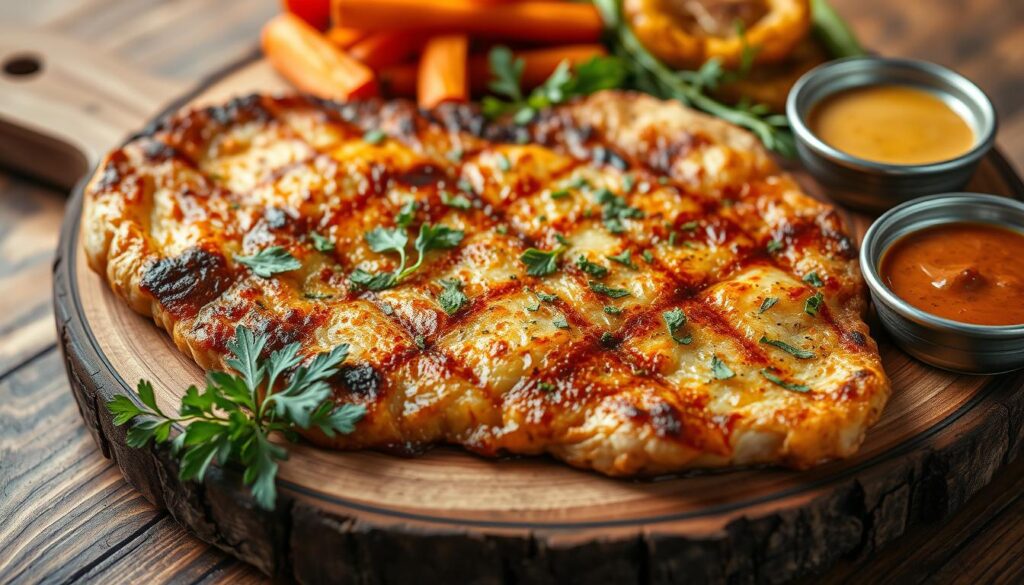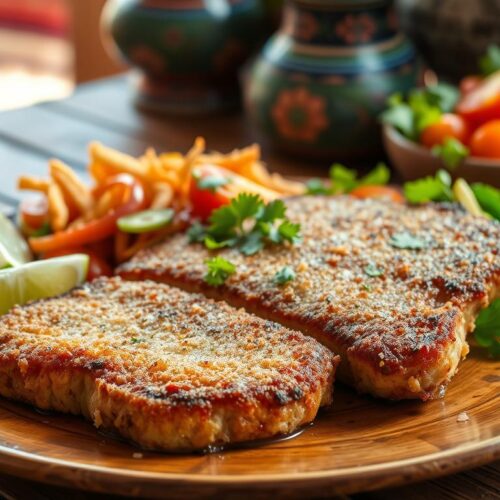Does milanesa steak make you think of South America’s lively streets? It started as simple comfort food there. Maybe you picture cooking this crispy steak in your kitchen, surrounded by your favorite sides. This dish is famous in Latino cuisine. It’s known for its crunch and its ability to be changed for different diets.
Chefs love making this South American dish. They pick the best cut, make it tender, and coat it in golden breading. You can choose beef, chicken, or a veggie option like eggplant. Milanesa steak is all about comfort. It’s crispy outside, tender inside, and makes a sizzle sound. Let’s learn how to make amazing milanesa at home. It will be a fun journey into Latino cuisine.
Key Takeaways
- Understanding milanesa steak’s rich history and its place in Latino cuisine.
- Exploring milanesa’s versatility beyond beef to suit different diets.
- Engaging in the art of choosing and preparing the steak perfectly.
- Discovering ways to make milanesa your own, from breadcrumbs to oils.
- Gaining insights on bringing this South American dish to your table.
The Origin of Milanesa Steak: A South American Delight
The Milanesa steak is a vital part of South American dish. It comes from the rich world of Latino cuisine. This crumbed beef dish is simple but tasty. It shows the cooking culture of the continent. Though often called an Argentinian steak, many Latin American cultures enjoy Milanesa.
History of Milanesa in Latino Cuisine
Milanesa got its inspiration from Italy’s cotoletta alla milanese. Immigrants in Argentina and Uruguay changed it a bit, making it their own. Now, it’s a key dish in many places, adding a personal touch in each area. Milanesa is more than food; it’s a sign of connection and tradition whether at a dinner in Buenos Aires or a busy spot in Montevideo.
Popularity Across Various Latin Countries
Milanesa is loved from Chile to Paraguay, showing how adaptable it is. In Bolivia, it’s a highlight at parties and celebrations. It’s not just in South America. In places like Miami, Milanesa is a favorite in Argentinian, Mexican, and Cuban restaurants. Its wide acceptance and adaptation show Milanesa’s lasting popularity and its part in Latin American food culture.
Cultural Significance of Milanesa in Latin America
Milanesa steak is not just food; it’s a key part of Latin American cuisine. It brings joy and brings families together at mealtime. You can find milanesa everywhere, from Buenos Aires’s busy streets to Mexico City’s vibrant markets. It’s a beloved dish, deeply rooted in the region’s traditional dishes.
The story of Latin American cuisine is rich with traditions and memories. Here, milanesa steak holds a special place. Each bite of milanesa is a bite of heritage and home. It’s not just food; it’s a festive celebration of warmth and community.
Across Latin America, milanesa is loved not just for its crispiness or tender meat. It’s valued as a dish that unites people, celebrating big and small moments together.
Looking at Latin America’s love for fancy steaks, the Tomahawk Steak is also worth exploring. Both dishes are known for their taste and cultural value. They are top choices in Latin American homes and elsewhere.
Milanesa steak is a bridge in Latin American cuisine. It connects stories, culture, and family bonds. It’s more than just eating. It’s about honoring a rich heritage with every tasty bite.
What Makes the Perfect Milanesa Steak?
Making the perfect Milanesa steak is a fine art. It begins with choosing premium ingredients and the right cooking methods. Let’s explore what elevates this Latin American dish into a delightful experience.
Choosing the Right Cut of Beef
The cut of beef is crucial for Milanesa. A thin steak like top round or sirloin is best because it cooks quickly and evenly. Using such a cut guarantees a tender meal and supports the breading, which gives Milanesa its crunch.
The Art of Tenderizing Thin Steak
Tenderizing is key for the perfect Milanesa. Pounding the tenderized beef with a mallet ensures it is thin and uniform in thickness. This lets it cook evenly and enhances texture, turning good beef into superb Milanesa.
Milanesa Versus Country Fried Steak
Milanesa and country-fried steak are both about breading and frying beef. Yet, Milanesa uses a thinner cut and lighter breading. This makes it different from the thicker and heavier breaded country-fried steak. These differences affect their cooking styles and how they taste in the end.
| Aspect | Milanesa Steak | Country Fried Steak |
|---|---|---|
| Cut of Beef | Top round or sirloin, very thin | Usually thicker, like cube steak |
| Type of Breading | Light, airy, often seasoned with herbs | Heavier, often with a milk-based batter |
| Cooking Method | Briefly fried, should remain tender | Fried then often simmered in gravy |
| Flavor Profile | Light and crispy, maintaining the beef’s flavor | Rich and hearty with a robust breading |
Coating and Breading Techniques for Crispy Steak
Getting a crispy steak just right means choosing a good coating and using breading techniques well. It’s key to understand how traditional breadcrumbs and panko affect your steak’s crispiness. Here, we’ll explore how each choice boosts the outer crisp of the steak. Plus, we’ll give tips on making sure the breading sticks well during cooking.
Breadcrumbs Vs. Panko: What Makes a Crisper Coat?
Deciding between breadcrumbs and panko is vital for a perfectly crispy steak. Breadcrumbs are finely ground, giving a dense crust with a classic crunch. In contrast, panko, a coarser Japanese breadcrumb, makes a steak crispy in a lighter, airier way. It absorbs less oil, so the steak feels less greasy. Generally, panko gives a crunchier bite, which is popular in many dishes today.

Secrets to Keeping the Breading Intact
To keep a steak’s coating perfect, it must stay on during cooking. Begin with flour, then an egg wash, and finish with breadcrumbs or panko. Here’s how to make the breading stick better:
- Dredge the steak lightly in flour, shaking off any excess.
- Dip thoroughly in the egg wash, letting extra drip off.
- Press the steak well into the breadcrumbs or panko, covering all sides.
- Let the breaded steak rest for 5-10 minutes before frying. This helps the coating to set.
Following these steps helps avoid the breading coming off while cooking. This ensures a crispy exterior, making the steak more enjoyable to eat.
Milanesa Steak: From Classic Recipes to Modern Twists
We explore the world of milanesa steak recipes, combining tradition with modern twists. Originally, milanesa steak was a basic breaded meat dish, important in Latin culture. Now, it’s a foundation for culinary innovation. This leads to many tasty variations that entice food lovers everywhere. The crunch of the breading and the flavor exploration mark the evolution of milanesa steak recipes. This delights food enthusiasts all over the globe.
How do we make a classic both new and familiar? Let’s look at ways chefs and home cooks add contemporary flair to this traditional dish:
- They use different breading, like panko, or mix breadcrumbs with parmesan and herbs for an Italian twist.
- Chefs experiment with marinades, adding flavors from chipotle, rosemary, or citrus before breading and frying.
- They top fried steaks with mozzarella cheese, fresh basil, and tomato sauce, making it similar to a crispy Parmigiana.
- Milanesa steak finds its way into sandwiches and salads, offering dishes that are both satisfying and innovative.
These modern twists do more than just expand the appeal of milanesa steak. They also reach out to a wider audience eager for new flavors and experiences, without straying too much from the beloved original. Through these tasty variations, the spirit of milanesa steak lives on. It shows that traditional dishes can always evolve.
Cooking Your Milanesa: To Fry or Not to Fry?
When we talk about Milanesa, the way you cook it really matters. Frying gives it that crunch we all love. But baking is becoming more popular for those who watch their health. Let’s dive into these methods and the best oils to use for a healthier Milanesa.
Comparing Cooking Methods: Pan-Frying vs. Baking
Frying milanesa makes it crunchy outside and juicy inside. The trick in frying is to keep the oil just hot enough. Baking is also a great way to cook Milanesa. It uses less oil, making the meal lighter. Make sure to heat the oven first and lightly grease the baking sheet for a crispy coating.
Choosing the Best Oil for a Healthier Option
Using the right oil is key for a tasty and nutritious meal. For frying, pick oils like grapeseed or peanut oil. They can handle the heat without releasing bad stuff. When baking, just brush some olive oil on the Milanesa. This way, it stays flavorful but healthier. These oils keep the cooking healthy without masking the Milanesa’s natural taste.

Unique Variations of Milanesa Across Latin America
In Latin America, milanesa has taken on many delightful forms. It suits both traditional and modern tastes. The Argentinian steak milanesa is known for its rich toppings and deep flavor. On the other hand, the rise of vegetarian milanesa shows how flexible this dish is. These Latin American variations keep milanesa loved from Argentina and beyond.
Argentinian Steak Milanesa: A National Icon
In South America, the Argentinian steak milanesa is especially beloved. It’s seen as a national dish. This variety involves a thin slice of beef, breaded and fried, often with ham and cheese on top. This mix reflects the Italian influence on Argentina’s food. It’s a vital part of both everyday meals and special events, marking it as a true Argentinian culinary icon. Click here to learn more about Argentinian cuisine: Argentinian culinary arts.
Adapting the Milanesa for Vegetarian and Vegan Diets
The milanesa is changing to fit vegetarian and vegan diets all over Latin America. Ingredients like soy, mushrooms, and eggplants are great meat substitutes. They keep the milanesa’s spirit alive without using meat. These versions also often use gluten-free flours for the coating. This makes them suitable for more people, including those with dietary needs.
| Ingredient | Use in Traditional Milanesa | Use in Vegetarian/Vegan Milanesa |
|---|---|---|
| Protein Base | Beef | Soy, Eggplant, Portobello |
| Toppings | Ham and Cheese | Dairy-free Cheese, Tomato Sauce |
| Breading | Standard Bread Crumbs | Gluten-free Flours |
Chefs are now taking milanesa to new heights with these changes. They are respecting its history while making it exciting for today’s tastes. Whether it’s traditional Argentinian steak milanesa or the new vegetarian milanesa, these dishes highlight Latin America’s rich food culture and its ability to evolve.
Bringing the Latin Flavor Home: Milanesa Steak in Your Kitchen
Making homemade milanesa adds delightful Latin flavor to your space. It turns your kitchen into a fun cooking spot. Begin with high-quality beef for tender bites, and choose the right breadcrumbs for a crispy coat.
At home, preparing milanesa lets you explore traditional Latin recipes. You can put your spin on it by adding special spices. It’s a chance to make the dish truly yours with flavors that mean something to you.
If you want to get good at making this, check out this guide. It has tips on picking the best beef and explains how to cook it slowly. This method needs patience, just like making a classic milanesa does.
| Ingredient | Role in Homemade Milanesa | Tips for Selection |
|---|---|---|
| Beef | Base of the dish | Opt for cuts like top round, thin enough to cook quickly yet hold moisture. |
| Breadcrumbs | Provides the crispy exterior | Panko for extra crispiness, or traditional breadcrumbs for a more authentic texture. |
| Eggs | Binds the breading to the beef | Use fresh, organic eggs for the best binding. |
| Oil | Medium for cooking | Choose high-smoke point oils like canola or peanut for best frying results. |
The best part about cooking at home isn’t just eating. It’s about making the meal. Homemade milanesa, whether for daily meals or special events, brings heartwarming Latin flavor. It celebrates the love and tradition found in Latin American kitchens.
Exploring Side Dishes to Complement Your Milanesa
Choosing the right milanesa side dishes is key to a better meal. These sides enhance the whole meal’s taste and texture. Let’s explore the top Latin sides and flavor pairing choices that will make your Milanesa meal unforgettable.
The Dance of Flavors: Pairing with the Right Sides
The secret to a great meal is in the flavor balance. For something as flavorful as Milanesa, picking the right flavor pairing is essential. Try combining it with fluffy rice or creamy mashed potatoes. These choices offer a nice texture contrast to Milanesa’s crunch, bringing the best of Latin sides to your plate.
Latin Sides: From Simple Rice to Complex Salads
Latin sides vary greatly, from simple seasoned beans to colorful, tangy salads. Pairing your Milanesa with sides like refried beans or a cool cucumber and tomato salad adds more than just volume to your meal. It introduces a mix of colors, textures, and tastes, making every bite a joy.
To find out how different sides can elevate your Milanesa, visit Mediterranean Latin Love Affair for recipes and cultural stories about this cherished dish.
| Side Dish | Description | Best For |
|---|---|---|
| Rice Pilaf | Lightly seasoned with garlic and onions, offers a subtle flavor that doesn’t overshadow the steak. | Complementing without competing |
| Refried Beans | Creamy texture with a hint of smokiness, adds a rich contrast. | Adding richness |
| Zarza (Tomato Salad) | Refreshing with a sharp, vinegary bite | Enhancing freshness |
| Cujuca Salad | Sweet corn with a mix of peppers, lime, and cilose salt | Balancing sweetness and zest |
Tips and Tricks for Perfecting Your Milanesa Steak Every Time
To cook a perfect milanesa steak, follow these cooking tips. They will lift your milanesa preparation skills. You can impress at dinner parties or boost your cooking talent. Stick to these rules for success.
- Tenderize the Meat Properly: With a meat mallet, pound the steak evenly. This makes it cook evenly and become tender.
- Season Before Coating: Always add salt, pepper, and spices before the breadcrumb coat. This makes the steak tasty.
- Select the Correct Oil and Pan: Choose a deep skillet and a neutral high smoke point oil, like canola or vegetable oil.
- Avoid Overcrowding the Pan: Don’t put too many steaks in the pan at once. This keeps them crispy.
- Drain Excess Oil: Lay the steaks on paper towels after frying. This keeps them crunchy and not greasy.
These milanesa preparation tips will improve your perfect milanesa steak cooking. Great milanesa isn’t just about ingredients. It’s also about how you cook it. Learn these steps to master Latin American cuisine.
Transforming Leftovers: Creative Ways to Reuse Milanesa Steak
Got leftover milanesa steak in the fridge? Don’t let it go to waste! Transforming leftovers is a fun chance to be creative. You can turn milanesa into new, exciting meals. Imagine enjoying it in a warm sandwich or sprinkled on a crisp salad. These ideas let you enjoy every last bite in new ways.
From Savory Sandwiches to Salads
Think about turning your leftover milanesa into something special. Add thin slices to a sandwich to make it stand out. Or chop it into bits and toss it in a salad for extra protein. Milanesa’s firm texture and savory breading let it pair well with bold flavors and sauces. This reinvents your meal into something delightful.
Incorporating Milanesa into Hearty Breakfast Dishes
Don’t just save milanesa for lunch or dinner. Adding it to your breakfast dishes can make mornings special. You can include it in an omelet, a breakfast burrito, or a breakfast hash. These creative uses make breakfast exciting. They also keep the delicious taste of milanesa as a morning favorite.
FAQ
What is Milanesa steak?
Milanesa steak is a well-known dish in Latin America. It is a thin slice of beef that’s breaded and fried. People love it for its crispy outside and tasty flavor.
Where did Milanesa originate and how did it become popular in Latin America?
Milanesa came from Italy and found a new home in South America. Over there, every country added its own twist, making it a favorite meal across the continent.
What cultural significance does Milanesa have in Latin America?
In Latin America, Milanesa is more than food. It’s a symbol of home and family reunions. This dish showcases cultural pride and brings countries together.
How do you choose the right cut of beef for Milanesa?
To make the best Milanesa, choose a lean cut like top round or sirloin. Make sure it’s thin and even for perfect tenderizing and breading.
What is the difference between Milanesa and country-fried steak?
Milanesa features thin, tender steaks without gravy. Country fried steak is thicker and often comes with gravy, marking a big difference between them.
Which is better for Milanesa breading: breadcrumbs or panko?
It’s all about what you like. Breadcrumbs give a classic feel, while panko offers a lighter crisp. Both options make Milanesa delicious in their own way.
What are some tips for keeping the breading intact on a Milanesa?
For perfect breading, tenderize the steak well and coat it thoroughly with flour and eggs before breadcrumbs. Fry at the right temperature to avoid losing the crust.
Can Milanesa be made in a healthier way?
Yes, you can bake or air-fry Milanesa for a healthy twist. Try whole wheat or gluten-free breadcrumbs to make it even better for you.
How does Argentinian steak Milanesa differ from other variations?
Argentinian Milanesa is special because it’s often topped with ham, cheese, and sometimes tomato sauce. This sets it apart from simpler versions.
What are some vegetarian alternatives to beef in Milanesa?
For a veggie Milanesa, use plant-based meats, portobello mushrooms, or eggplant. These options mimic meat’s texture, offering a delightful substitute.
What are some classic side dishes to serve with Milanesa?
Serve Milanesa with rice, refried beans, salads, or Zarza (marinated tomatoes). These sides enhance the steak’s crispy and savory taste.
How can you repurpose leftover Milanesa steak?
Turn leftover Milanesa into tasty sandwiches, salad toppings, or a breakfast treat. This is a great way to enjoy it all over again while cutting waste.

Milanesa Steak Recipe
Equipment
- Meat mallet (optional)
- Shallow bowls for breading
- Frying pan or skillet
- Tongs
- Paper towels
Ingredients
- 4 thin-cut beef steaks about 1/4 inch thick, such as round or sirloin
- 2 large eggs
- 1 cup all-purpose flour
- 1 cup breadcrumbs
- 1/4 cup grated Parmesan cheese optional
- 1 tsp garlic powder
- 1 tsp onion powder
- 1 tsp paprika
- Salt and pepper to taste
- Vegetable oil for frying
- Lemon wedges for serving
Instructions
Prepare the Steaks:
- If the steaks are too thick, use a meat mallet to pound them to about 1/4 inch thickness. Season both sides of the steaks with salt and pepper.
Set Up the Breading Station:
- In one shallow bowl, add the flour.
- In a second bowl, beat the eggs with a pinch of salt and pepper.
- In a third bowl, combine the breadcrumbs, Parmesan cheese (if using), garlic powder, onion powder, paprika, and a bit of salt and pepper.
Bread the Steaks:
- Dredge each steak in the flour, shaking off any excess.
- Dip the steak into the beaten eggs, ensuring it’s fully coated.
- Finally, press the steak into the breadcrumb mixture, coating both sides evenly.
Fry the Steaks:
- In a large frying pan or skillet, heat about 1/4 inch of vegetable oil over medium heat. Once the oil is hot, carefully add the breaded steaks.
- Fry for 3-4 minutes per side, or until golden brown and crispy. Use tongs to flip the steaks carefully.
- Once cooked, transfer the steaks to a plate lined with paper towels to drain the excess oil.
Serve:
- Serve the Milanesa steaks with lemon wedges on the side for squeezing over the top. Enjoy with a side of rice, mashed potatoes, or a fresh salad.
Notes
Chicken or pork can be used instead of beef for this recipe.
To make it a meal, serve the Milanesa steak with fries or in a sandwich with lettuce, tomato, and mayo.



